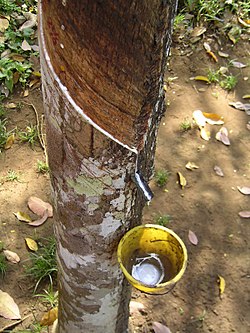This is an old revision of this page, as edited by Aaron Brenneman (talk | contribs) at 10:07, 23 December 2005 (I really really want to be able to use that picture, but "fair use" can't be stretched that far. See talk.). The present address (URL) is a permanent link to this revision, which may differ significantly from the current revision.
Revision as of 10:07, 23 December 2005 by Aaron Brenneman (talk | contribs) (I really really want to be able to use that picture, but "fair use" can't be stretched that far. See talk.)(diff) ← Previous revision | Latest revision (diff) | Newer revision → (diff)
- See also LTEX, a macro package for the TEX typesetting system., Latex, Texas for the rural community
Latex, as found in nature, is the milky sap of many plants that coagulates on exposure to air. It is a complex emulsion in which proteins, alkaloids, starches, sugars, oils, tannins, resins and gums are found. In most plants latex is white, but some have yellow, orange, or scarlet latex.
The word also refers to the thin stretchy material obtained by processing the sap (see Latex as clothing, below). It can also be made synthetically by polymerizing a monomer that has been emulsified with surfactants.
Sources
The cells or vessels in which latex is found make up the laticiferous system, which forms in two very different ways. In many plants the laticiferous system is formed from rows of cells laid down in the meristem of the stem or root. The cell walls between these cells are dissolved so that continuous tubes, called latex vessels, are formed. This method of formation is found in the poppy family, in the rubber tree, and in the Cichorieae, a section of the Family Asteraceae distinguished by the presence of latex in its members. Dandelion, lettuce, hawkweed and salsify are members of the Cichorieae.
In the milkweed and spurge families, on the other hand, the laticiferous system is formed quite differently. Early in the development of the seedling latex cells differentiate, and as the plant grows these latex cells grow into a branching system extending throughout the plant. In the mature plant, the entire laticiferous sytem is descended from a single cell or group of cells present in the embryo.
The laticiferous system is present in all parts of the mature plant, including roots, stems, leaves, and sometimes the fruits. It is particularly noticeable in the cortical tissues.
Function and usage
Latex has been attributed to many plant functions. Some regard it as a form of stored food, while others consider it an excretory product in which waste products of the plant are deposited. Still others believe it functions to protect the plant in case of injuries; drying to form a protective layer that prevents the entry of fungi and bacteria. Similarly, it may provide some protection against browsing animals, since in some plants latex is very bitter or even poisonous. It may be that latex fulfills all of these functions to varying degrees in the numerous plant species in which it occurs.
Latex has many uses, from clothing to paint, but its first and foremost is rubber. Chicle, widely used as a base for chewing gum, is another latex product. Latex paint use synthetic latex as a binder, which is not flammable, has little odor, and cures to form a dry paint film. Finally, poppy latex is a source of opium and its many derivatives.
Some people have a serious latex allergy, and exposure to latex or rubber products such as rubber gloves or condoms can cause anaphylactic shock. As latex has a protein found also in bananas, care should be taken to ensure people are not allergic to both. Guayule latex is hypoallergenic and is being researched as a substitute to the allergy inducing Hevea latexes.
Latex as clothing
Latex is used in many types of clothing. It is different from rubber in that it is less refined and often less thick. Worn on the body it tends to be skin-tight, producing a "second skin" effect. It is also a lot more shiny than the more matte rubber.
Latex as a clothing material is common in BDSM fashion and at fetish clubs, and there are several magazines dedicated to the use and wearing of it.
See also
External links
- Free latex fetish photography by Alexander Horn
- Community website for fans of latex and rubber clothing
- Marquis magazine's online latex and rubber news
- Skin Two, one of the largest online latex/rubber fetish communities which also publishes it's own magazine
- Skin Two Rubber Ball, an event dedicated to both latex wear and rubber